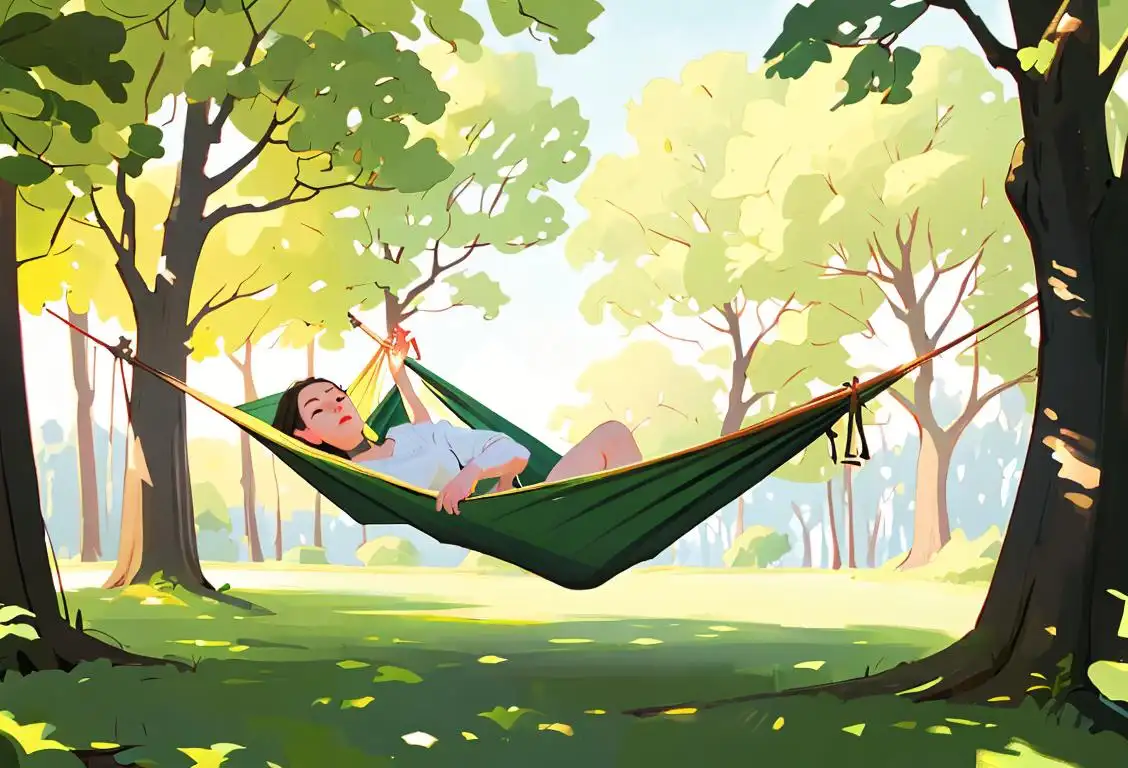National Stay In Bed All Day

Are you tired of the daily grind? Dreaming of staying snuggled up in bed all day? Well, you're in luck because today is National Stay in Bed All Day! This delightful holiday is all about giving yourself permission to indulge in much-needed rest and relaxation. So, grab your comfiest pajamas, fluff up your pillows, and get ready to embrace the bliss of a lazy day in bed!
When is Stay In Bed All Day?
It's national stay in bed all day on the 30th October.
The Origins of National Stay in Bed All Day
While the specific origin of National Stay in Bed All Day is unknown, the concept of taking a day off from our hectic lives to lounge in bed has been around for ages. From the ancient Egyptians who believed sleeping was a way to communicate with the gods, to the lazy Sundays of our grandparents' generation, people have long understood the value of a good lie-in.
In the age of the internet, National Stay in Bed All Day has gained popularity as a way to unplug from the digital world and prioritize self-care. It's a day to hit the snooze button, ignore alarm clocks, and embrace the simple pleasure of staying cozy in bed.
Celebrating National Stay in Bed All Day
Celebrating National Stay in Bed All Day is as simple as it sounds. Just give yourself permission to stay in bed for as long as you want! Whether you sleep in until noon, catch up on your favorite TV shows, read a good book, or cuddle with your loved ones, the choice is yours. It's a guilt-free day to pamper yourself and recharge.
But if you're worried about productivity, fear not! Staying in bed doesn't mean you can't be productive. You can set up a cozy workspace with a laptop, blanket, and a cup of coffee or tea. Just make sure to balance work with relaxation and don't forget to take breaks and stretch your legs!
A Fun Fact About National Stay in Bed All Day
Did you know that there are scientific benefits to staying in bed longer? Studies have shown that adequate rest can improve memory, creativity, and overall cognitive function. So, the next time someone tells you that staying in bed all day is lazy, you can proudly tell them that you're actually boosting your brain power!
History behind the term 'Stay In Bed All'
1884
The Invention of the Spring Mattress
In 1884, the spring mattress was invented by the German engineer Heinrich Westphal. This innovative mattress design featured metal coil springs that provided enhanced support and comfort for a good night's sleep. The spring mattress quickly gained popularity among the general public, making it easier to stay in bed all day long.
1944
The Birth of 'Stay in Bed All Day'
In the year 1944, the term 'stay in bed all day' emerged as a popular phrase in the English language. It referred to the act of indulging in the comfort and luxury of staying in bed for an entire day, without any specific reason or obligations to fulfill. This phrase gained popularity as a symbol of relaxation and self-care, signifying a break from the hectic pace of daily life.
1880
The Invention of the Spring Mattress
In the year 1880, the first modern spring mattress was invented. Prior to this, most beds were made of straw, feathers, or horsehair. The invention of the spring mattress revolutionized sleeping comfort by providing better support and cushioning for the body. This led to a significant increase in the quality of sleep, making staying in bed more appealing.
1900
The Invention of the Phrase
In the year 1900, the phrase 'stay in bed all' was first coined. It was used as an expression to describe the desire or temptation to remain in bed for an extended period of time. This phrase quickly gained popularity and became associated with the idea of taking a break from the demands of everyday life by indulging in the comfort and relaxation of staying in bed.
1834
The Invention of the Spring Mattress
In 1834, British upholsterer James Marshall invented the first spring mattress. This innovation introduced a new level of comfort and support to the sleeping experience. The flexible coil springs distribute weight evenly, reducing pressure points and allowing for a more restful sleep.
1931
The Birth of 'Stay in Bed All Day'
The term 'stay in bed all day' originated in 1931 when a humorous column titled 'Stay in Bed All Day' was published in the London Evening Standard. The column, written by humorist A.P. Herbert, promoted the idea of taking a day off and staying in bed as a form of relaxation and escape from the stresses of daily life. It quickly gained popularity and entered the cultural lexicon, representing the desire for a carefree day of laziness and indulgence.
1930
The Birth of Modern Bedroom Culture
In the 1930s, there was a cultural shift that emphasized the importance of relaxation and leisure time. This led to the emergence of modern bedroom culture, where spending leisure time in bed became a popular activity. People started associating their bedrooms with comfort, relaxation, and personal space, leading to the concept of staying in bed as a way to indulge in self-care.
1855
The Rise of Adjustable Beds
In 1855, American inventor Leonard C. Bailey patented the first adjustable bed frame. This allowed users to raise or lower the head and foot of the bed to their desired position. Adjustable beds added versatility and convenience, making it easier for people to find their preferred sleeping position.
1925
Emergence in Pop Culture
By 1925, the concept of 'stay in bed all' had become more widely recognized in popular culture. It started appearing in newspapers, magazines, and even in entertainment mediums such as films and theater. The phrase resonated with people who yearned for moments of rest and escapism amidst the fast-paced and hectic nature of modern life.
1907
Introduction of the Pillow Top Mattress
In 1907, the pillow top mattress was introduced by Sealy. This new mattress design featured an extra layer of padding sewn onto the top, providing additional softness and luxury. The pillow top mattress offered unparalleled comfort, making it even more tempting to stay in bed and enjoy its cozy embrace.
1970
Counterculture Embraces 'Stay in Bed All'
During the 1970s, the counterculture movement embraced the idea of 'stay in bed all,' reflecting a desire to break free from societal norms and expectations. This term became associated with a rejection of the traditional 9-to-5 work culture and a celebration of personal autonomy. 'Stay in bed all' represented a rebellious act of self-expression, aligning with the spirit of the times.
1960s
Countercultural Movement and 'Stay in Bed All Day'
During the 1960s, the countercultural movement embraced the concept of 'stay in bed all day' as a form of protest and a rejection of traditional societal norms. The phrase became synonymous with the idea of resisting the pressures of the working world and instead prioritizing personal freedom and self-expression. It represented a desire for a different way of living, characterized by leisure and individualism.
1940s
The Emergence of Popular Culture References
During the 1940s, popular culture started to embrace the idea of staying in bed as an indulgent and leisurely activity. Films, literature, and advertisements began to depict characters staying in bed for extended periods, often associated with luxury and relaxation. This portrayal of 'staying in bed all' captured the imagination of the public.
1931
The Rise of Electric Blankets
In 1931, the first electric blanket was sold to the public by the Electric Auto-Lite Company. This technological advancement allowed for controllable warmth during colder months, ensuring a toasty and comfortable bed. With the introduction of electric blankets, staying in bed all day became even more enjoyable.
1950
The Rise of Television and Bedtime Entertainment
In the 1950s, television became widely popular, and many households started having TVs in their bedrooms. This introduced the concept of bedtime entertainment, where people could watch shows or movies from the comfort of their own beds. Staying in bed became a way to enjoy entertainment and unwind after a long day, further solidifying the idea of staying in bed as a pleasurable activity.
1990
The Rise of 'Stay in Bed All Night'
In the 1990s, an alteration of the phrase emerged with the term 'stay in bed all night.' While 'stay in bed all day' emphasized daytime relaxation, 'stay in bed all night' highlighted the idea of indulging in the comfort and intimacy of the nighttime hours. This term became particularly popular among couples, symbolizing a cozy and intimate retreat from the outside world.
1973
John Lennon's 'Bed-In for Peace'
In 1973, the term 'stay in bed all day' gained further prominence when John Lennon and Yoko Ono staged their famous 'Bed-In for Peace' in Amsterdam and Montreal to protest against the Vietnam War. The couple stayed in bed for an extended period, inviting the media and visitors to discuss peace and spread their message of non-violence. Their peaceful and unconventional protest captured the public's attention and inspired many to use the concept of 'stay in bed all day' as a form of peaceful resistance.
1960
Celebrity Endorsements and Lifestyle Trend
During the 1960s, celebrity endorsements of 'stay in bed all' as a lifestyle trend further boosted its popularity. Influential figures, particularly those in the entertainment industry, began advocating for self-care and prioritizing mental well-being. The idea of 'stay in bed all' became associated with a form of self-indulgence, promoting the importance of taking time for oneself and embracing relaxation.
1973
The Notorious 'Stay in Bed All Day' Song
In 1973, British singer-songwriter Danny Kirwan released the single 'Stay in Bed All Day.' The catchy tune became a minor hit and popularized the phrase globally. The song's lyrics depicted a desire to escape responsibilities and remain in bed, resonating with many who longed for a carefree day of lounging.
1990
Social Media Spread and Memes
With the rise of the internet and social media in the 1990s, the phrase 'stay in bed all' took on a whole new life. Memes, viral posts, and online communities embraced the concept, often using it humorously to express laziness or a desire to avoid responsibilities. This widespread digital dissemination helped propel 'stay in bed all' into the realm of internet culture and solidify its place in modern lexicon.
2005
Social Media Amplification
With the advent of social media platforms, the popularity of the term 'stay in bed all' soared. People began sharing their experiences and desires to 'stay in bed all,' using hashtags and creative captions. This digital amplification of the phrase further solidified its cultural significance, turning it into a global phenomenon and a symbol of self-care and relaxation.
1980s
Pop Culture References and 'Stay in Bed All Day'
Throughout the 1980s, the term 'stay in bed all day' continued to be referenced in popular culture, appearing in songs, movies, and literature. It became an iconic symbol of rebellion, leisure, and self-care. Artists embraced the idea of staying in bed as a means of escape from the demands of society, and the phrase took on a romanticized and aspirational quality.
1967
The Invention of the Waterbed
In 1967, Charles Hall invented the waterbed, a mattress filled with water that provided a unique floating sensation while sleeping. The waterbed quickly gained popularity, especially with the counterculture movement of the 1960s and 1970s. This unconventional mattress made staying in bed an experience on its own.
1970
Sleep Science and the Importance of Rest
During the 1970s, there was a rise in sleep science, which brought attention to the importance of rest and proper sleep for overall health and well-being. This increased awareness on the benefits of staying in bed to get enough sleep and recharge. The concept of 'staying in bed all' became associated with self-care and prioritizing one's physical and mental health.
Present Day
Self-Care Movement and 'Stay in Bed All Day'
In the present day, 'stay in bed all day' has evolved into a key component of the self-care movement. It is seen as a way to prioritize mental and physical well-being, allowing individuals to recharge, relax, and practice mindfulness. The term has become a popular hashtag on social media, with people sharing their experiences of indulging in a day of rest and rejuvenation. It has become a symbol of the importance of self-care in a fast-paced and demanding world.
2021
National 'Stay in Bed All' Day
Today, 'stay in bed all' has become so ingrained in popular culture that it has its own dedicated national day. National 'Stay in Bed All' Day is celebrated annually on a specific date to encourage individuals to take a break, prioritize self-care, and enjoy the simple pleasure of staying in bed. It serves as a reminder of the importance of rest and relaxation in our fast-paced modern lives.
2000
The Digital Age and Staycation Culture
With the advent of the internet and smartphones in the early 2000s, staying in bed took on a new meaning. The digital age allowed people to work, socialize, and entertain themselves from the comfort of their own beds. Additionally, the rise of staycation culture, where people would take time off work to relax at home, further popularized the idea of staying in bed as a way to unwind and enjoy a break without leaving the house.
Present
National Stay in Bed All Day Day
In the present day, 'stay in bed all' has become more than just a phrase; it is now a celebrated national day. National Stay in Bed All Day Day, observed on December 15th each year, encourages people to take a break from their routine and allow themselves a day of indulgent relaxation in bed. It serves as a reminder of the importance of self-care and mental well-being in today's busy world.
1990s
The Rise of the 'Stay in Bed All' Mentality
During the 1990s, the 'Stay in Bed All' mentality gained traction as a counter-cultural movement against the fast-paced lifestyle. The term became a symbol of self-care, encouraging individuals to prioritize rest, relaxation, and mental well-being. This cultural shift towards recognizing the importance of downtime further popularized the phrase.
1984
The Advent of Memory Foam Mattresses
In 1984, NASA introduced memory foam to the public through the development of pressure-relieving seat cushions. This viscoelastic material was later used in mattresses, contouring to the body's shape and providing exceptional comfort. The arrival of memory foam mattresses made it even more tempting to stay in bed all day and experience the unique sensation of being cradled by the foam.
2007
The Emergence of Smart Beds
In 2007, smart beds started hitting the market, incorporating advanced technology to enhance sleep quality. These beds integrated features such as adjustable firmness, sleep tracking, and temperature control. With smart beds, people could personalize their sleep experience and make staying in bed all day a more indulgent and customized affair.
Present
National 'Stay in Bed All Day' Day
Today, 'Stay in Bed All Day' has become more than just a playful phrase. It has inspired the creation of National 'Stay in Bed All Day' Day, celebrated on different dates around the world. This unofficial holiday encourages people to take a break from their hectic lives, unwind, and enjoy the comfort of their beds.
Did you know?
Did you know that there are scientific benefits to staying in bed longer? Studies have shown that adequate rest can improve memory, creativity, and overall cognitive function.Tagged
fun loved ones relaxationFirst identified
7th January 2016Most mentioned on
30th October 2016Total mentions
16Other days
Ewa Beach Day
Pampering Day
Bathtub Party Day
Fl Day
Lie Around At Home In Your Pajama Pants Day
Slowdown Day
Drop Everything And Read Day
Eat Outside Day
Healing Day
Nap Nap Day







